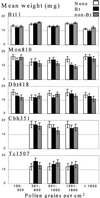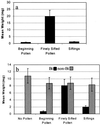Monarch larvae sensitivity to Bacillus thuringiensis- purified proteins and pollen
- PMID: 11559841
- PMCID: PMC59744
- DOI: 10.1073/pnas.211297698
Monarch larvae sensitivity to Bacillus thuringiensis- purified proteins and pollen
Abstract
Laboratory tests were conducted to establish the relative toxicity of Bacillus thuringiensis (Bt) toxins and pollen from Bt corn to monarch larvae. Toxins tested included Cry1Ab, Cry1Ac, Cry9C, and Cry1F. Three methods were used: (i) purified toxins incorporated into artificial diet, (ii) pollen collected from Bt corn hybrids applied directly to milkweed leaf discs, and (iii) Bt pollen contaminated with corn tassel material applied directly to milkweed leaf discs. Bioassays of purified Bt toxins indicate that Cry9C and Cry1F proteins are relatively nontoxic to monarch first instars, whereas first instars are sensitive to Cry1Ab and Cry1Ac proteins. Older instars were 12 to 23 times less susceptible to Cry1Ab toxin compared with first instars. Pollen bioassays suggest that pollen contaminants, an artifact of pollen processing, can dramatically influence larval survival and weight gains and produce spurious results. The only transgenic corn pollen that consistently affected monarch larvae was from Cry1Ab event 176 hybrids, currently <2% corn planted and for which re-registration has not been applied. Results from the other types of Bt corn suggest that pollen from the Cry1Ab (events Bt11 and Mon810) and Cry1F, and experimental Cry9C hybrids, will have no acute effects on monarch butterfly larvae in field settings.
Figures


Comment in
-
Bt or not Bt: is that the question?Proc Natl Acad Sci U S A. 2001 Oct 23;98(22):12328-30. doi: 10.1073/pnas.241503398. Proc Natl Acad Sci U S A. 2001. PMID: 11675483 Free PMC article. No abstract available.
References
-
- Losey J E, Rayor L S, Carter M E. Nature (London) 1999;399:214. - PubMed
-
- Kreig A, Langenbruch G A. In: Microbial Control of Pests and Plant Diseases. Burges H D, editor. New York: Academic; 1981. pp. 837–896.
-
- Peacock J W, Schweitzer D F, Dale F, Carter J L, Dubois N R. Environ Entomol. 1998;27:450–457.
-
- Miller J C. Am Entomol. 1990;36:135–139.
-
- Johnson K S, Scriber J M, Nitao J K, Smitley D R. Environ Entomol. 1995;24:288–297.
Publication types
MeSH terms
Substances
LinkOut - more resources
Full Text Sources
Other Literature Sources

